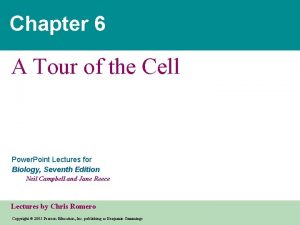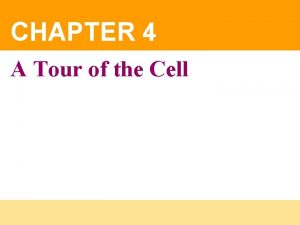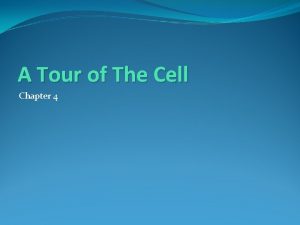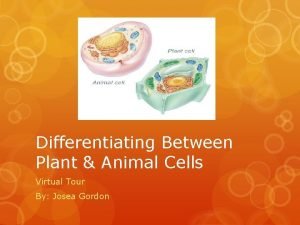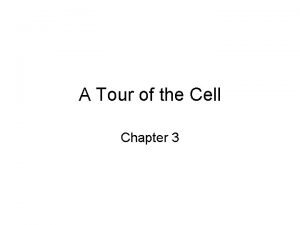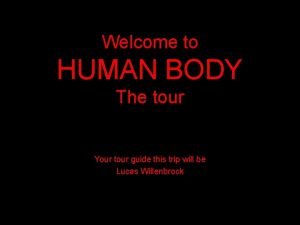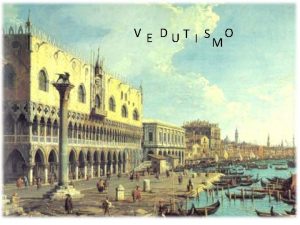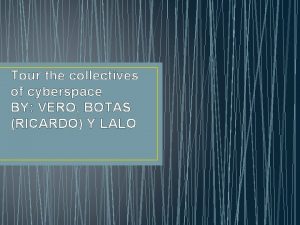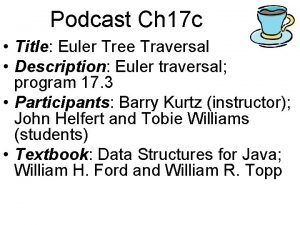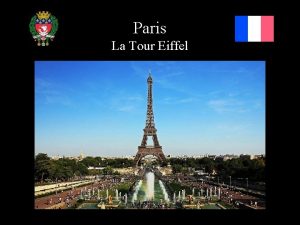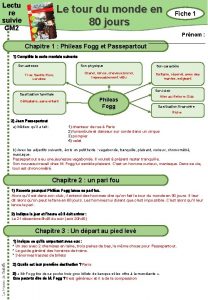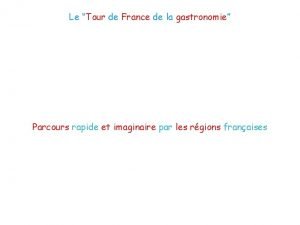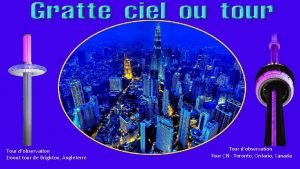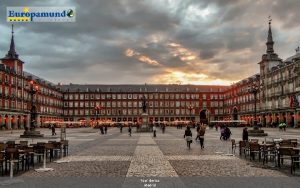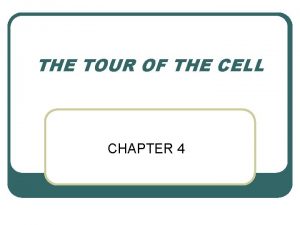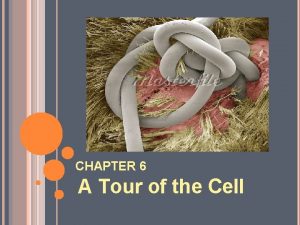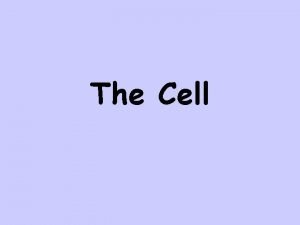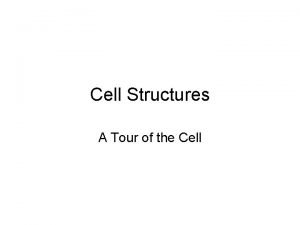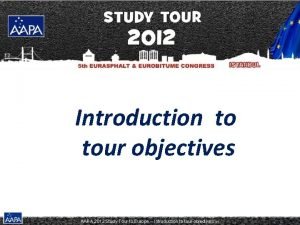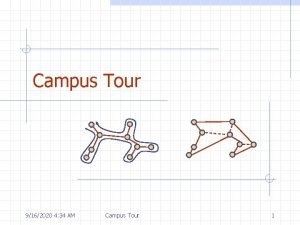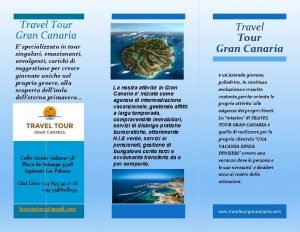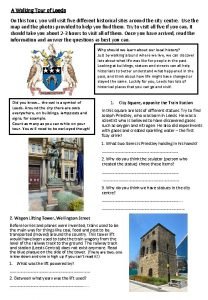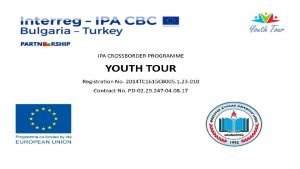Chapter 7 A Tour of the Cell Cell


































































- Slides: 66

Chapter 7 A Tour of the Cell

Cell Theory Microscope – Developed during the 1500’s by eyeglass makers • Made cell research possible • Robert Hook – observed compartments in a thin slice of cork (1665) • • He named these compartments cells He was actually viewing the walls of dead cells (plant cells)

Cell Theory Anton van Leeuwenhoek (1675): was the first person to observe living cells.

Cell Theory – All living things are composed of cells, AND that cells are the basic unit of structure and function in all living things • Added to theory later is that all cells come from cells

Cell Theory Who developed the cell theory? • Matthias Schleiden (1838): concluded that all plants are composed of cells • Theodor Schwann (1839): concluded that all animals are composed of cells • Rudolph Virchow (1855): determined that cells come only from other cells

Microscopes 1. • Light Microscope Magnifies Objects up to 1000 times actual size Appendix B- A 14

Microscopes Magnification: refers to the microscope’s power to increase an object’s apparent size Resolution: refers to the microscope’s power to show detail clearly


Microscopes Electron Microscope • Can magnify up to 1, 000 times • Enough to see details inside the cell Scanning Electron Microscope (SEM) • Used to study the surface structures of cells. 2.

Microscopes Transmission Electron Microscope (TEM) • Used to study internal cell structures

Microscopes Specimens for the electron microscope must be killed and preserved before viewing. • This is why the light microscope is useful for observing living cells. Micrograph – a photograph of the view through a microscope. •

Cell Diversity- Size Biggest Cells: 6 inches long, 5 inches wide, 3 pounds Ostrich Egg

Plant and Animal Cell – Similarities Organelle – Part of a cell with a specific function Similarities Plants and Animals Plasma Membrane – defines the boundary of the cell and regulates the traffic of chemicals between the cells and it surrounding.

Plant and Animal Cell Nucleus – Houses cells genetic material (DNA) Cytoplasm – the entire region of the cell between the nucleus and the plasma membrane • Consists of various organelles suspended in a fluid • Most organelles each have their own membranes; meant to help keep their own environments separate.

Plant and Animal Cell - Differences Chloroplast – found in some plant cells; responsible for photosynthesis • Converts light energy to chemical energy Cell Wall – A strong cell wall outside the plant cell and maintains its shape.

Plant and Animal Cell - Differences Cells differ widely in shape. • Most cells are roughly cuboidal or spherical. •

Multi-cellular organisms show emergent properties • Emergent properties arise from the interaction of the component parts; the whole is greater than the sum of the parts'.

Cell Differentiation: Cells within a multi cellular organism specialize their function.

Stem Cells a stem cell that has the potential to differentiate into any of the three germ layers: • • endoderm (interior stomach lining, gastrointestinal tract, the lungs) mesoderm (muscle, bone, blood, urogenital), ectoderm (epidermal tissues and nervous system). • Pluripotent stem cells can give rise to any fetal or adult cell type. However, alone they cannot develop into a fetal or adult organism because they lack the potential to contribute to extraembryonic tissue, such as the placenta.

Two Classes of Cells 1. Prokaryotic Cells – Lack a nucleus and most other organelles Nucleoid Region – area in a prokaryotic cells where DNA is concentrated • Includes: Bacteria, Archaea • Appeared earliest in Earth’s fossil records.

Binary Fission

Two Classes of Cells 2. Eukaryotic Cells – has a nucleus surrounded by its own membrane and has internal organelles bounded by membranes. Includes: protist, fungi, plants, and animals • Fossil records has them appear after prokaryotic cells


Membranes This is what made life possible • Membranes keep Eukaryotic cells organized • Membranes regulate transport of substances across the boundary – allow certain substances to pass. • Maintains a specific and unique environment within each compartment it encloses. •

Plasma Membranes Composed mostly of proteins and a type of lipid called phospholipids • Phospholipids are structured like fats: • • Has two fatty acids instead of 3 Hydrophilic – water loving Hydrophobic – water fearing

Plasma Membranes Phospholipid structure enables them to form boundaries or membranes • A cells environment is aqueous; inside (cytoplasm) and out • • This requires that a cell forms two structures inside and out, like a sandwich Phospholipid Bilayer - the two layer sandwich of molecules that surrounds a cell. It surrounds the cell and some organelles.

Phospholipid Bilayer This creates a selected barrier. • Non-polar molecules like oxygen and carbon dioxide • Polar molecules like sugars and other ions do not.

Plasma Membranes Together with proteins; membranes are dynamic; fluid like…… • Proteins move in a sea of phospholipids. • • Like an iceberg

Function of Membrane Protein Many types of proteins are embedded in the membranes phospholipid bi-layer • • Carbohydrates may be attached to the membrane as well

Function of Membrane Protein 1. 2. 3. Protein perform, in some if not most cell’s functions • Enzymes catalyze reactions near the cell Help cells communicate with each other • Chemicals release signals that can be “picked up” by proteins embedded in the membrane of another cell Transport Proteins – Help move certain substances across the membrane. Polar molecules need help to get through a cells membrane

Membranes Diffusion • the net movement of the particles of a substance from where they are more concentrated to where they are less concentrated. • Molecules and fluid are in constant motion, colliding and bouncing as they spread out into available space.

Membranes Equilibrium • Molecules moving across a membrane is equal to the number moving in the other direction

Passive Transport Cellular membranes are barriers to the diffusion of some substances Selectively Permeable Membrane – allows substances to cross the membrane more easily than others and blocks the passage of some substances all together. • In a typical cell a few molecules (mainly O₂ & CO₂) diffuse freely through the membrane. • Water also diffuses through the protein molecules (channels)

Passive Transport Diffusion across a membrane uses no energy is expended by the cell. • Only the random motion of molecules are required to move them across the membrane • Most small molecules still have restricted access.

Facilitated Diffusion Transport proteins provide a pathway for certain molecules to pass. • Specific proteins allow the passive transport of different substances. • • This allows for specific proteins to allow the passive transport of different substances This helps substances including some ions and smaller polar molecules, like water and sugar, to diffuse in and out of the cell.

Facilitated Diffusion Both diffusion and facilitated diffusion are forms of passive transport = NO ENERGY

Osmosis The passive transport of water across a selectively permeable membrane Hypertonic – a solution with higher concentration of solute. Hypotonic – a solution with lower solute concentration Water will go from Hypotonic hypo ( = below) to Hypertonic (hyper = above) Isotonic – solution in which the concentration of solute are equal. • Iso = equal

Animal Cells vs. Plants Cells Animal cells need to maintain a isotonic environment to maintain balance – be HAPPY • A plant cell to maintain firmness needs to be hypotonic • • • Animal cells can burst with too much water In a plant cell; the cell wall prevents too much water from entering the cell, preventing bursting. Isotonic = limp stem cell death

Active Transport When a cell expends energy to move molecules or ions across a membrane • Protein “pumps” a solute across a membrane, usually in the opposite direction to the way it travels in diffusion • Requires chemical energy supplied by the mitochondria Active Transport play a vital role in maintaining the cells chemical environment. •

Transport of Large Molecules Vesicles – small membrane sacs that specialize in moving products into, out of and within a cell. • Protein made in the cell then moved out Exocytosis – the fusion of a particle (in vesicle) to the inner wall of a cell membrane and spilling its contents out of the cell.

Transport of Large Molecules Endocytosis – takes in material into the cell within vesicles that bud inward from the plasma membrane.

The Cell Products - Nucleus • Nucleus contains DNA • DNA directs the activities of the cell • DNA is attached to certain proteins, forming long fibers called Chromatin. • • Normally chromatin looks like a plate of spaghetti During reproduction they organize.

Nuclear Envelope Surrounds the nucleus. • Substances made in the nucleus move into the cells cytoplasm through tiny holes, or pores, in the nuclear envelope. Nucleolus – a ball like mass of fibers and granules; these parts make up organelles called ribosome.

Ribosome Where proteins are constructed. • DNA has the information, ribosomes make the protein. • Function like “assembly lines” making protein. • Ribosomes are actually clusters of protein and nucleic acids – formed in the nucleus. Some ribosomes are bound to membranes in the cytoplasm; make proteins found in the membrane and exported by the cell. • Some ribosomes are suspended in the cytoplasm • • They make enzymes and other proteins that remain in the cytoplasm

Endoplasmic Reticulum An extensive network of membranes • Main transportation and manufacturer of the cell • It is a maze of membranes arranged as tubes and sacs that separates the inside of the endoplasmic reticulum (ER) from the cytoplasm.

Endoplasmic Reticulum 1. • • Two Regions of ER They are connected but different Rough ER – Named because of bound ribosomes outside the ER membrane. These ribosomes produce proteins that are packaged in vesicles by the ER and later exported or secreted by the cell. Specialized Cells – Salivary Glands are rich in ER because they secrete enzymes in your mouth

Endoplasmic Reticulum 2. • Smooth ER – lacks ribosomes, by using enzymes in ER membrane helps to build lipid molecules Specialized Cells – cells in the ovaries and testes produce sex hormones have a large amount of smooth ER.

Golgi Apparatus An organelle that modifies, stores, and routes proteins and other chemical products to their next destinations • enzymes in the golgi apparatus refine and modify ER products by altering their chemical structure. • Some products of the golgi apparatus are used in the cell; some are secreted out by exocytosis, out of the cell.

Secretory Pathway

Vacuoles Large membrane-bound sacs Store undigested nutrients Contractile Vacuole – found in some single-celled freshwater organisms • Pumps excess water out of the cell

Vacuoles Central Vacuole – found in plants; can be large Stores chemicals like salt • Helps with plant growth by causing the cells to expand • Flower Central Vacuoles have pigments that give color • Some contain poisons – for protection •

Lysosomes Another membrane-bound sacs, contain enzymes that break down macromolecules like: Proteins Nucleic Acids Polysaccharides Function: • Fuse with incoming food vacuoles and help digest nutrients for the cell • Help destroy harmful bacteria • White blood cells • Serve as recycling center for damaged organelles • It can engulf and digest another organelle

Chloroplast and Mitochondria Chloroplast – are the photosynthetic organelles found in some cells of plants and algae. Photosynthesis – the conversion of light energy from the sun to the chemical energy stored in sugars and other organic compounds

Chloroplast and Mitochondria Chloroplast have an envelope; made of two membrane • Internal membranes divide the chloroplast into compartments Chloroplast’s solar “power packs” – the structures that actually trap light energy and convert it to Chemical energy.

Chloroplast and Mitochondria – in eukaryotic cells; are sites where cellular respiration occurs. Cellular Respiration – the process that releases energy from sugars and certain other organic molecules and then uses it to form ATP • ATP (adenosine triphosphate) is the main energy source that cells use for most of their work • Mitochondria is found in almost all kinds eukaryotic cells – including plants and algae.

Mitochondria Structure: • Like all organelles – structure = function • Like chloroplast two membranes surround mitochondria • • • Inner membrane has numerous in foldings Enzymes and molecules relate to cellular respiration are built into inner membrane. Folds increase surface area; the area in which cellular respiration takes place.

Mitochondria Fold are like the lines of Disney World; increases the number of people in a small areas.

Peroxisomes Structure: spherical organelles that contain enzymes within single membranes Function: Degrade hydrogen peroxide, a toxic compound that can be produced during metabolism.

Cytoskeleton A network of fibers extending through out the cytoplasm • These fibers are constantly breaking down and rebuilt Microtubules – straight, hollow tubes of proteins that give rigidity, shape, and organization to a cell. • Also provide “tracks” for organelles to move.

Cytoskeleton

Cytoskeleton Microfilaments – thinner solid rods of proteins; enable the cell to move or change shape when protein subunits slide past one another. • This processes are seen in the movements of amoeba and white blood cells.

Flagella (flagellum-singular) are long, thin, whip-like structures, with a core of microtubules that enable some cells to move • Usually waves with an S-shaped motion that propels the cell

Cilia Are generally shorter and more numerous than flagella • Contains bundles of microtubules, move in a back -and-forth motion – like oars

Flagella and Cilia and flagella can also extend from stationary cells • • Not for motion, move fluid or trap debris

Organelles do not work together. They work independent of each other.

Organelle Prokaryote Or Eukaryote Plant or Animal Cell Function Nucleus Eukaryote Both Holds the DNA (genetic information) of cells – has a membrane that allows RNA to be transported in and out Ribosome Both Where proteins are made during translation Mitochondria Eukaryote Both Cellular respiration occurs here to produce ATP this is the power house of the cell Chloroplast Eukaryote Plant Photosynthesis occurs here in plant cells Endoplasmic Reticulum (ER) Eukaryote Both “highway of the cell” and site of protein and lipid synthesis Golgi body Eukaryote Both Sorts and packages cellular products like the post office of the cell Lysosome Eukaryote Both Breaks down waste products Cell Wall Both Plant Protects plant and some prokaryotic cells; supports cell Vacuole Eukaryote Plant Stores water and waste, supports cell to make it rigid Cell Membrane Both Controls what enters and exits a cell. It is made up of a lipid bilayer that is selectively permeable (only small and non-polar molecules can pass through it). Large and/or charged molecules must go through transport proteins embedded in the membrane. Passive transport does not require energy (high concentration to low concentration). Active transport requires energy (low concentration to high concentration) Cytoplasm Both The water-like substance that takes up most of a cell
 Tour petronas et tour eiffel
Tour petronas et tour eiffel Escort tours
Escort tours Dangerous world tour
Dangerous world tour Intercellular connections
Intercellular connections A tour of the cell chapter 4
A tour of the cell chapter 4 A tour of the cell chapter 4
A tour of the cell chapter 4 Virtual cell tour
Virtual cell tour A tour inside the cell answers
A tour inside the cell answers Chapter 4 cell theory and cell study
Chapter 4 cell theory and cell study Hát kết hợp bộ gõ cơ thể
Hát kết hợp bộ gõ cơ thể Ng-html
Ng-html Bổ thể
Bổ thể Tỉ lệ cơ thể trẻ em
Tỉ lệ cơ thể trẻ em Chó sói
Chó sói Glasgow thang điểm
Glasgow thang điểm Chúa yêu trần thế alleluia
Chúa yêu trần thế alleluia Kể tên các môn thể thao
Kể tên các môn thể thao Thế nào là hệ số cao nhất
Thế nào là hệ số cao nhất Các châu lục và đại dương trên thế giới
Các châu lục và đại dương trên thế giới Công thức tính độ biến thiên đông lượng
Công thức tính độ biến thiên đông lượng Trời xanh đây là của chúng ta thể thơ
Trời xanh đây là của chúng ta thể thơ Mật thư tọa độ 5x5
Mật thư tọa độ 5x5 Phép trừ bù
Phép trừ bù độ dài liên kết
độ dài liên kết Các châu lục và đại dương trên thế giới
Các châu lục và đại dương trên thế giới Thơ thất ngôn tứ tuyệt đường luật
Thơ thất ngôn tứ tuyệt đường luật Quá trình desamine hóa có thể tạo ra
Quá trình desamine hóa có thể tạo ra Một số thể thơ truyền thống
Một số thể thơ truyền thống Cái miệng xinh xinh thế chỉ nói điều hay thôi
Cái miệng xinh xinh thế chỉ nói điều hay thôi Vẽ hình chiếu vuông góc của vật thể sau
Vẽ hình chiếu vuông góc của vật thể sau Biện pháp chống mỏi cơ
Biện pháp chống mỏi cơ đặc điểm cơ thể của người tối cổ
đặc điểm cơ thể của người tối cổ V. c c
V. c c Vẽ hình chiếu đứng bằng cạnh của vật thể
Vẽ hình chiếu đứng bằng cạnh của vật thể Phối cảnh
Phối cảnh Thẻ vin
Thẻ vin đại từ thay thế
đại từ thay thế điện thế nghỉ
điện thế nghỉ Tư thế ngồi viết
Tư thế ngồi viết Diễn thế sinh thái là
Diễn thế sinh thái là Dạng đột biến một nhiễm là
Dạng đột biến một nhiễm là Các số nguyên tố
Các số nguyên tố Tư thế ngồi viết
Tư thế ngồi viết Lời thề hippocrates
Lời thề hippocrates Thiếu nhi thế giới liên hoan
Thiếu nhi thế giới liên hoan ưu thế lai là gì
ưu thế lai là gì Sự nuôi và dạy con của hổ
Sự nuôi và dạy con của hổ Khi nào hổ con có thể sống độc lập
Khi nào hổ con có thể sống độc lập Sơ đồ cơ thể người
Sơ đồ cơ thể người Từ ngữ thể hiện lòng nhân hậu
Từ ngữ thể hiện lòng nhân hậu Thế nào là mạng điện lắp đặt kiểu nổi
Thế nào là mạng điện lắp đặt kiểu nổi Welcoming tourist
Welcoming tourist Tour of body.com
Tour of body.com Virtual bus tour
Virtual bus tour Vedutismo camera ottica
Vedutismo camera ottica Virtual tour sarthe
Virtual tour sarthe Tour the collectives of cyberspace
Tour the collectives of cyberspace Tbilisi tour package
Tbilisi tour package Euler tour traversal
Euler tour traversal Gif tour eiffel
Gif tour eiffel Tipos de tour operador
Tipos de tour operador Letter of enquiry to travel agency
Letter of enquiry to travel agency Carte mentale le tour du monde en 80 jours
Carte mentale le tour du monde en 80 jours Teurgole
Teurgole Http://teacher.scholastic.com/activities/immigration/tour/
Http://teacher.scholastic.com/activities/immigration/tour/ Virtual tour builder
Virtual tour builder Tour guide objectives
Tour guide objectives



